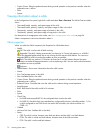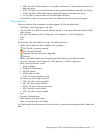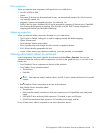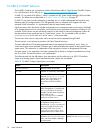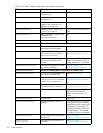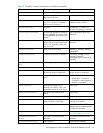
HP StorageWorks 2000 G2 Modular Smart Array Reference Guide 77
A SNMP reference
This appendix describes the Simple Network Management Protocol (SNMP) capabilities that 2000 G2
Modular Smart Array storage systems support. This includes standard MIB-II, the FibreAlliance SNMP
Management Information Base (MIB) version 2.2 objects, and enterprise traps.
2000 G2 Modular Smart Array storage systems can report their status through SNMP. SNMP provides
basic discovery using MIB-II, more detailed status with the FA MIB 2.2, and asynchronous notification using
enterprise traps.
SNMP is a widely used network monitoring and control protocol. It is an application layer protocol that
facilitates the exchange of management information between network devices. It is part of the Transmission
Control Protocol/Internet Protocol (TCP/IP) protocol suite.
SNMP enables network administrators to manage network performance, find and solve network problems,
and plan for network growth. Data is passed from SNMP agents reporting activity on each network device
to the workstation console used to oversee the network. The agents return information contained in a
Management Information Base (MIB), which is a data structure that defines what is obtainable from the
device and what can be controlled (turned on and off, etc.).
An SNMP object identifier (OID) is a number assigned to devices in a network for identification purposes.
OID numbering is hierarchical. Using the IETF notation of digits and dots resembling very long IP
addresses, various registries such as ANSI assign high-level numbers to vendors and organizations. They,
in turn, append digits to the number to identify individual devices or software processes.
2000 G2 Modular Smart Array systems use SNMPv2c, which improves on SNMPv1 features and uses its
community-based security scheme.
Standard MIB-II behavior
MIB-II is implemented to support basic discovery and status.
In the system group, all objects can be read. The contact, name, and location objects can be set.
The system object identifier (sysObjectID) is based on the vendor name followed by “.2.” and the
identifier for the particular product model. For example, the object identifier for 2000 G2 Modular Smart
Array storage systems is 1.3.6.1.4.1.11.2.51, where 51 is assigned for hpMSA. System uptime is an offset
from the first time this object is read.
In the interfaces group, an internal PPP interface is documented, but it is not reachable from external to the
device.
The address translation (at) and external gateway protocol (egp) groups are not supported.
Enterprise traps
Traps can be generated in response to events occurring in the storage system. These events can be selected
by severity and by individual event type. A maximum of three SNMP trap destinations can be configured
by IP address.
Enterprise event severities are informational, minor, major, and critical. There is a different trap type for
each of these severities. The trap format is represented by the HP enterprise traps MIB,
msa2000traps.mib. Information included is the event ID, the event code type, and a text description
generated from the internal event. Equivalent information can also be sent using email or popup alerts to
users who are logged in to SMU.
The text of the trap MIB is included at the end of this appendix.




